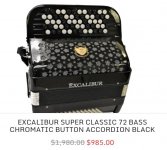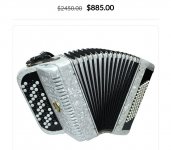I agree with Tom. I am 73. I played diatonic accordion on and off for ten years or so; much taken with the lightness and handiness, but increasingly irked by the musical limitations. I finally took the plunge a couple of years ago and bought a chromatic button accordion to see if I could hack it. Much to my surprise I found the transition much less work than I expected. The initial purchase was part-exchanged for a rather splendid, if a bit weighty, Paolo Soprani 120 bass four voice instrument. This has to be played sitting down, so the load on the back is modest, the burden is borne by the left thigh. A good chair is essential; expensive, but well worthwhile.
In your part of the world of course the vast majority of chromatic accordions will have piano keyboards. If you are already a pianist then the choice is simple. If not, I would recommend you consider a button instrument. The keyboard is, in my opinion, more logical than a piano keyboard, and with a five row instrument the fingering for the major scale may be identical in all keys. even with three rows there are only three fingerings for all major scales. It is quite easy to stretch to span two octaves, and the chord shapes in the right hand are identical for all chords.
As you have noted, the flexibility of a stradella bass is much broader than even the most well endowed diatonic instruments (typically 18 basses). Indeed, once you start pushing the diatonic envelope with more basses and voices you find that the size of the instrument soon approximates that of a small chromatic accordion and is less flexible.
I still like to play both, as well as my guitar and sundry other plucked string instruments. I have, however, largely laid the diatonics to one side and am concentrating on my learning the chromatic button. After going at it quite diligently for over two years (including the periods of ghastly Covid lockdown) I am now able to play simple arrangements of such French standards as “La Vie En Rose”, “Plaisir D’Amour” etc. I’m even struggling with Satie’s “Gymnopedie 1”. I’m still progressing.
I would recommend you consider trying a small instrument such as the Pigini Peter Pan or similar. These are sized to suit young children just starting the instrument, but they are quite playable with adult hands, and are, of course, smaller and lighter than most medium to large sized accordions. Given that the players for whom they are bought eventually either tire of the instrument or wish to progress to a larger one they come on the market in good condition from time to time.
On the two Hohners you mention, I can give no opinion on the Corona, but I have owned a Bravo briefly. I bought it at what I thought to be a good price. I found it to be rather raucous and poorly finished. It was, of course, a chromatic button one, but the innards of the piano instruments I am sure will be identical. I believe that they are made in China, and that this accounts both for the cheap price and poor quality. I would always choose a European made accordion now. As the Rolls Royce publicity used to assert, the quality remains long after the price is forgotten.
Good luck in your retirement folly, from another elderly fool.ere are


